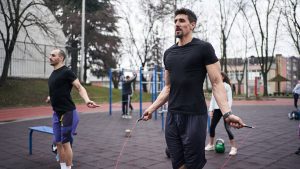
Maria Åberg and Malin Henriksson of the University of Gothenburg discuss how symptoms of anxiety disorders can be alleviated through physical activity.
Anxiety is the body’s natural response to stress. It is a feeling of fear or unease, particularly a feeling of apprehension about what could happen in the future. Although everyone will experience anxiety in their lifetime, for some people, anxiety and constant worrying can affect their daily lives. Generalised anxiety disorders (GAD) cause sufferers to feel anxious most days. GAD is most commonly found in people from the ages 35-59, with the condition slightly affecting more women than men.1

One of the most effective treatments for anxiety disorders is cognitive behavioural therapy (CBT). Based on the concept that your thoughts and feelings are connected with your actions and physical sensations; CBT helps to deal with problems by breaking them down into smaller sections.
CBT, however, does not work for everyone, especially as people are faced with long waiting lists to gain access to the treatment. Due to this, other treatments to relieve symptoms of anxiety disorders are being explored, such as exercise. A study led by University of Gothenburg researchers has shown that both moderate and strenuous exercise can alleviate anxiety symptoms. To find out more about this study, HEQ spoke to the University of Gothenburg’s Maria Åberg and Malin Henriksson.
Can you give me an overview of what happens in our brains when we exercise?
We know that the brain’s plasticity changes when we exercise. Numerous studies, both in human and non-human animal research, support aerobic fitness training. They also support resistance exercise, showing that it can have a positive effect on multiple aspects of brain function and cognition throughout the lifespan. Several neurotrophic factors, such as molecular and cellular changes in the brain, are induced by exercise and appear to underlie the effects of fitness on cognition and performance.
Regular fitness training has been observed to enhance angiogenesis (stimulate new formation of blood vessels), synaptogenesis (communication between nerve cells and synapses in the brain), and neurogenesis (new formation of nerve cells from stem cells) especially in the hippocampus, a centre for cognitive functions, emotions, memory, and learning in the brain.
Exercise also upregulates a number of neurotrophic factors in the brain: BDNF (brain derived neurotrophic factor) counteracts ageing, inflammation, and oxidative stress, and VEGF (vascular endothelial growth factor) and IGF-1 (insulin-like growth factors) stimulate angiogenesis. Physical exercise enhances the activity of the PGC-1α/FNDC5/Irisin pathway leading to neuronal survival, and further changes muscle fiber characteristics. It has beneficial effects on mental health, enhancing IGF-1, PI3K, BDNF (serum and brain), ERK, and reducing GSK3β levels. These physiological changes contribute to cell proliferation and survival, inhibiting cell death, and changes the morphology of the dendrites and consequently, the development of anxiety and depression.
Although a broad spectrum of possible mechanisms exists, explaining the effect of exercise on anxiety including the neurotransmitter, neuromodulator, and psychological mechanisms is difficult as the precise mechanism remains unclear.

The training sessions included cardio (aerobic) and strength training, what types of exercise did these involve specifically? How did you motivate participants to exercise, and do you think they benefited from exercising in groups?
The exercise programme was designed as a circuit training with 12 stations, repeated twice. Cardiorespiratory exercises included step-ups, lunges, jump rope, burpees, step touches side-to-side, and step-touches on step boards. Resistance training exercises included squats, abdominal plank position, hip lifts, crunches, row exercises, and push-ups. Every exercise included three times 10 repetitions (or as many as the time frame and the patient’s group-intensity allowed, following pulse and BORG-scale). Each training session lasted for one hour, including 10 minutes of warm-up exercises and five minutes of cool-down and stretching.
A registered physiotherapist from a primary health care rehabilitation designed individualised programmes during a single one-on-one session with the patients during the first days. The intervention groups then exercised in separate sessions under the guidance of the physiotherapist. The physiotherapist attended all exercise sessions, registered attendance, and also motivated patients by being there for them for guidance and support when they experienced symptoms of anxiety disorders. These symptoms are similar to the physical reactions when you exercise, for example tremors, experience of palpitations, and dizziness.
The social participation in a group context with a supporting physiotherapist could be therapeutic in itself. The regular sessions might be one explanation for the symptom reduction. Almost one-third of the participants in the present study were on sick-leave so regular meetings with others probably had a beneficial effect in this group.
Is there an optimal amount of exercise people should be doing to safeguard and improve their mental wellbeing? Have you seen changes in participants’ exercise routines following the program?
From our study we can only say that both cardiorespiratory and resistance exercises, for at least three times per week for 45-60 minutes, improves the participants’ mental well-being in 12 weeks. What we know is that physical activity has many positive effects on our health, as it is associated with a lower risk of several chronic diseases. At the same time, a sedentary lifestyle is linked with an increased risk of disease, and this means that both physical activity and not engaging in sedentary activities and/or limiting the amount of time spent being sedentary, should be recommended. Replacing sedentary time with physical activity of any intensity (including light intensity) provides health benefits.
The Swedish recommendations for physical activity adhere to WHO’s recommendations which entail that all adults should be physically active for a minimum of 150 minutes per week of at least moderate intensity (for high intensity 75 minutes per week is recommended).
WHO’s recommended dose of exercise for well-being in adults aged 18–64 years is:
- Should do at least 150–300 minutes of moderate-intensity aerobic physical activity;
- Or at least 75–150 minutes of vigorous-intensity aerobic physical activity; or an equivalent combination of moderate- and vigorous-intensity activity throughout the week;
- Should also do muscle-strengthening activities at moderate or greater intensity that involve all major muscle groups on two or more days a week, as these provide additional health benefits;
- May increase moderate-intensity aerobic physical activity to more than 300 minutes; or do more than 150 minutes of vigorous-intensity aerobic physical activity; or an equivalent combination of moderate- and vigorous-intensity activity throughout the week for additional health benefits;
- Should limit the amount of time spent being sedentary. Replacing sedentary time with physical activity of any intensity (including light intensity) provides health benefits; and
- To help reduce the detrimental effects of high levels of sedentary behaviour on health, all adults and older adults should aim to do more than the recommended levels of moderate- to vigorous-intensity physical activity.
Did you see any changes in participants’ lifestyles over the course of the program such as changes in their diet or sleep habits for instance?
We have not yet investigated this specifically, but further publications will address these issues.
Can you highlight some of the key challenges associated with the management and treatment of anxiety disorders? How do you hope your study will impact and inform primary health care for people with anxiety?
Today’s standard treatments for anxiety disorders are CBT and pharmacological treatment. Despite notable pharmacological advances, treatment resistance, side effects, and poor medication adherence are common among patients with anxiety disorders. Long waiting lists, which is common for CBT, may worsen symptoms and long-term prognosis. GPs within primary health care need treatments that are low on side effects and easily prescribed.
Our results support an exercise intensity trend for reduced anxiety symptoms, as almost all patients in intervention groups go from a high/severe anxiety score (BAI-score) at baseline (before intervention) to a low/mild score after intervention (12 weeks). We therefore have strong evidence for implementing exercise as a treatment in primary care. The results were also independent of depressive symptoms.
In Sweden today, specific guidelines for treating anxiety disorders with exercise are missing and we hope that our research can lead to more specific guidelines in the future, as there is for depression. Moreover, structured physical activity represents an effective treatment and should be more frequently made available for persons with anxiety issues within primary health care.
References
- www.nhs.uk/mental-health/conditions/generalised-anxiety-
disorder/overview/
This article is from issue 20 of Health Europa Quarterly. Click here to get your free subscription today.









